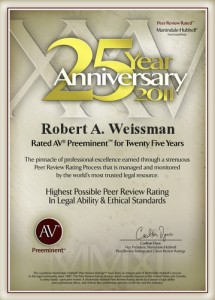 Robert A. Weissman represents general contractors, subcontractors, suppliers, rental companies and other trade, testing and design professionals, spec builders and owners in connection with public (state, local and federal) and private (residential, commercial and industrial property) from contract and contract provision review and advice, preparation, negotiation, course of construction issues and disputes and in mediation, arbitration and litigation including breach of contract, change order, extra work, delay, defective work and performance disputes; foreclosure of mechanics’ liens, enforcement of stop notices, payment bonds and subdivision improvement and similar bonds, substitution hearings, Contractors State License Board matters, in making and resisting license bond claims, other bond claims, bid protests and claims against public entities (for breach of contract, change order, extra work disputes, failure to obtain payment bonds and other claims and disputes).
Robert A. Weissman represents general contractors, subcontractors, suppliers, rental companies and other trade, testing and design professionals, spec builders and owners in connection with public (state, local and federal) and private (residential, commercial and industrial property) from contract and contract provision review and advice, preparation, negotiation, course of construction issues and disputes and in mediation, arbitration and litigation including breach of contract, change order, extra work, delay, defective work and performance disputes; foreclosure of mechanics’ liens, enforcement of stop notices, payment bonds and subdivision improvement and similar bonds, substitution hearings, Contractors State License Board matters, in making and resisting license bond claims, other bond claims, bid protests and claims against public entities (for breach of contract, change order, extra work disputes, failure to obtain payment bonds and other claims and disputes).
He assists his clients in exercising and defending their rights under the Mechanics’ Lien law. He reviews, negotiates, drafts and enforces their contracts and credit applications both prior to and after commencing a lawsuit and bring lawsuits to foreclose on Mechanics’ Liens, enforce Stop Notices, bond claims, breach of contract, negligence and for collection of past due or disputed accounts and contracts.
He also assists his clients with real estate contracts, real estate investments, transactions and disputes. He handles all aspects of the matter including mediation, arbitration and trial and in the exercise of their pre and post-judgment collection remedies.
For over 20 years he presented “how to” seminars on topics which include how to prepare and serve preliminary notices, Mechanics’ Liens and Stop Notices, Releases, how to exercise bond claim rights, how to get paid when you have no lien rights, what to include in prime and sub-contracts and what not to agree to, how to protect your rights from the beginning, what to include in credit applications and rental agreements and updating changes in Mechanics’ Lien and Construction law. He has presented programs on Mechanics’ Lien Law for the Real Property Section of the State Bar at its Annual Retreat and at the State Bar Annual Convention.
He is an arbitrator and mediator with the American Arbitration Association on the construction and real estate panels. In addition to construction matters, he is available to hear real estate matters and commercial, bank collection and title related disputes. For both arbitration and mediation regular track claims, he is available to travel to hearings throughout California. He is also an experienced real estate, bond and cryptocurrency investor and is an amateur photographer.
He is a graduate of UCLA and Southwestern University School of Law and attended Chapman College World Campus Afloat during his junior year. He is a past president of the San Fernando Valley Bar Association, a past trustee of the Los Angeles County Bar Association. He is admitted to practice before all California Courts, U.S. Districts Courts in California and the United States Supreme Court. He is also admitted to practice in the District of Columbia. He has been named an Outstanding Young Man in America, has received awards from the City of Hope (where he served on the President’s Advisory Council), California Lawyers for the Arts, The City of Los Angeles, Mayors of the Cities of Los Angeles and San Fernando, the Los Angeles County District Attorney, California State Assembly, California State Senate, United States Congress, Los Angeles City Attorney, County of Los Angeles and has been listed in Who’s Who in California, Who’s Who in American Law and Who’s Who in the World for almost 30 years.
He is rated AV or Preeminent by a Martindale-Hubbell Peer Review Rating which reflects a combination of achieving a the highest available, Very High, General Ethical Standards rating and the highest available Legal Ability numerical rating. He is also rated Preeminent by the Martindale-Hubbell Client Review Rating which is determined through aggregation of validated responses on a scale of 1-5. 1 being lowest as Rated and 5 being highest as Preeminent.

loading …
loading …
